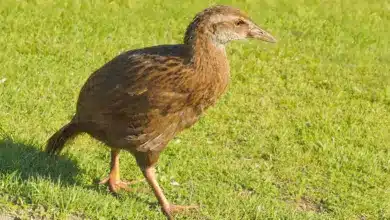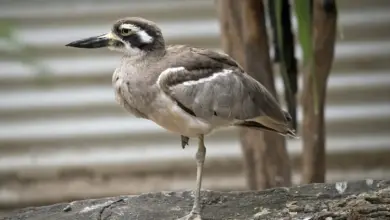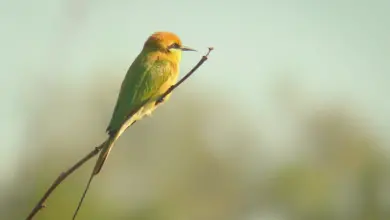The Clark’s Grebes (Aechmophorus clarkii) – also known as Mexican Grebe – is a North American grebe that is native to Canada, Mexico, and the United States.
This large grebe is identified by its long, swan-like neck, and contrasting black and white plumage.
The Clark’s Grebe is a white-faced version of the Western Grebe, and until the 1980s, it was thought to be a pale morph (genetic mutation) of the Western Grebe. However, these two species rarely interbreed – probably due to differences in face and bill coloration, or advertising calls.
It was named after John Henry Clark – a 19th-century American surveyor, naturalist, and collector.

Alternate (Global) Names
Chinese: ???? … Czech: potápka Clarkova, Potápka mexická … Danish: Gulnæbbet Lappedykker … Dutch: Clark-fuut, Clarks Fuut … German: Clark Taucher, Clarktaucher, Clark-Taucher … Estonian: hele-suurpütt … Finnish: Meksikonuikku … French: Grèbe à face blanche, Le Grèbe de Clark, Grèbe élégant … Italian: Svasso cigno di Clark, Svasso di Clark … Japanese: kuraakukaitsuburi … Norwegian: Gulnebbdykker, Sørsvanedykker … Polish: perkoz zóltodzioby, perkoz ?ó?todzioby … Russian: ??????? ?????? … Slovak: potápka bielolíca … Spanish: Achichilique, Acitli, Achichilique de Clark, achichilique pico, Achichilique Pico Naranja, achichilique pico-naranja, Achichilique Piquinaranja … Swedish: Ljus svandopping, Vitbrynad svandopping
Distribution
The Clark’s Grebes’s breeding range stretches from south-central British Columbia east to southwestern Manitoba, south to Minnesota, Colorado, New Mexico, Arizona, and California.
They winter from central California to Colorado, south to Baja California and central Mexico.
There are also resident populations in California, Nevada, the Lower Colorado River in Arizona, and central Mexico.
They inhabit lakes, marshes, and bays. During the winter, they also occur along seacoasts.
Subspecies and Ranges
- Aechmophorus clarkii clarkii (Lawrence, 1858) – Nominate Race
- Range: Mexican Plateau from northern Chihuahua to northern Guerrero, Nayarit (Western Mexico), and New Mexico.
- Aechmophorus clarkii transitionalis (Dickerman, 1986)
- Range: Western United States, north to Utah and Colorado.
Description
The Clark’s Grebes measure 21.7–29.5 inches (55–75 cm) in length, and have a wingspan of 31.9–32.3 inches (81–82 cm). They weigh between 25.3–59.4 oz (718–1685 g).
The plumage is black-and-white. The back, wings, and cap are blackish-brown to black. The face is white, as are the neck and underplumage. The eyes are red. They have a long, slender, swan-like neck. The feet are set back on the body.
The long, thin bill is slightly upturned and bright yellow, which differentiates this species from the Western Grebe, which has a straight and greenish-yellow bill. The Clark’s Grebe has white around the eyes, while those areas are black in the Western Grebe.
Gender ID: Males and females look alike.
Immature birds resemble the adults.

Similar Species:
- The Western Grebe is identical to the Clark’s Grebe in terms of size, shape, behavior, and natural range. The Western’s Grebe can be identified by the black coloration around the eyes and greener bill. However, during the winter, the facial patterns of these two species are nearly identical, making identification much more challenging. However, these two species also have distinctive calls: The Clark’s Grebe call is a single “great” while the Western Grebe‘s call is a doubled note.
- The Red-necked Grebe is smaller than the Western Grebe and lacks the bold black and white neck pattern. The winter plumage of the Red-necked Grebe is a dingy grey – not bright white.
- Horned and Eared Grebes are smaller. They have shorter bills that are never yellow.
- Loons are larger with longer bodies; their bills are larger and darker; they have shorter necks and their wings are entirely dark.
Breeding / Range
Most breeding activity is observed in June and July.
Clark’s Grebes nest on large inland lakes over shallow water on a floating platform of vegetation.
They perform the same elaborate courtship display as the Western Grebe.
The average clutch consists of 2 – 7 (mostly 3 – 4) bluish-white eggs that are about 2.3 inches (58 mm). The eggs are incubated by both parents for about 23 days. The hatchlings are covered in white down. The young fledge when they are about 63 – 77 days old.
Diet / Feeding
Clark’s Grebes mostly feed by diving underwater, propelled by their feet, as they pursue fish, such as carp and herring, which make up the largest part of their diet. They will also eat mollusks, crabs, salamanders, and insects.





